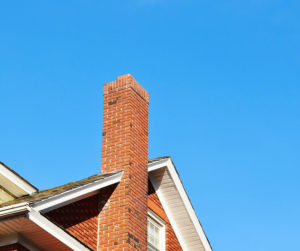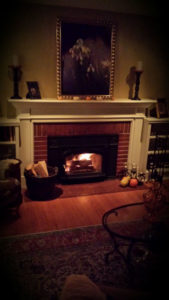Spring has officially arrived, and warmer weather is right around the corner. This means we have new, spring discounts for you to take advantage of! With four incredible coupons available for our customers, now is the perfect time for fireplace and chimney services.
$40 off a chimney sweep that includes an inspections
Our first spring coupon gives customers $40 off a chimney sweeping that includes an inspection. This special helps ensure your fireplace is clean and safe after a long winter of use – while helping you save money!
Regular chimney maintenance, including sweepings and inspections, is the best way to keep your fireplace burning safely and efficiently. Chimney sweepings help remove soot, ash, flammable creosote, and other blockages from the flue. Chimney inspections help ensure that the entire fireplace and chimney system is in good condition and free from areas of damage or deterioration.
Annual maintenance is recommended by major safety organizations as well. The Chimney Safety Institute of America recommends all homeowners have their chimneys swept at least once per year – if not more; the National Fire Protection Association recommends all fireplace be inspected at least once per year as well.
Complete chimney protection – 15% off chimney waterproofing package
Now that spring is here, we know that rain is right around the corner. To ensure your chimney is ready, we are offering our second spring discount, 15% off our chimney waterproofing package. Water is the leading cause of masonry damage. Guarantee a prepared chimney by having out team waterproof your system!
No charge repair estimates
Whether you have a chimney leak, damaged masonry, or want to reface your firebox, now is the perfect time to call one of the chimney experts at Jack Pixley Sweeps [https://jackpixleysweeps.com/]. Our third spring discount gives customers the opportunity to receive no charge repair estimates; if you have a chimney or fireplace repair that needs to be completed, stop putting it off and call for your no charge repair estimate today!
$40 off a dryer vent cleaning with a sweep
We might be known for our fireplace and chimney services – but we can clean your dryer vents, too! Our fourth spring coupon gives customers $40 off a dryer vent cleaning with a chimney sweeping.
The same lint that accumulates in the lint trap after each load can build up over time in the dryer vents. This is harmful in two ways. First, lint build up can restrict air flow in the dryer vents, forcing the dryer to work harder and negatively impacting performance. Second, lint is extremely flammable. The superheated air the dryer produces as it compensates for restricted airflow can ignite and lead to an accidental dryer fire. Cleaning dryer vents can improve dryer efficiency while reducing the risk of dryer fires.
Don’t forget about your masonry repairs, too!
Early spring is the perfect time of year to take care of any masonry repairs that may have arisen over the winter. The weather is perfect for masonry to cure properly. The weather ensures your repairs are completed as quickly as possible. Likewise, spring is often a low-use season for fireplaces. Having repairs done now ensures your fireplace will be ready to use again next fall.
Make sure you are gearing up for spring properly, by taking advantage of our seasonal deals! Contact Jack Pixley Sweeps today for more information about how to take advantage of our spring coupons!
While fireplaces and chimneys are built to last, they do not always work as efficient over time. Improper construction, damage, and operator error can all contribute to the fireplaces from burning as safely and efficiently. When you experience any sort of performance or drafting problems, you should turn to a chimney sweep for help!
How chimneys work
 Chimneys are able to draft because of hot air. When a fire is lit in the firebox, the air inside the chimney begins to get warmer – and less dense – than outside air. As the air gets warmer, it begins to rise. As the warm air rises, cooler air is drawn into the fireplace to fan the fire. This further pushes the warm air up the chimney. While this seems simple, even small changes can really make the draft inside your chimney. Some examples are fireplace design, chimney construction, fuel source, or maintenance.
Chimneys are able to draft because of hot air. When a fire is lit in the firebox, the air inside the chimney begins to get warmer – and less dense – than outside air. As the air gets warmer, it begins to rise. As the warm air rises, cooler air is drawn into the fireplace to fan the fire. This further pushes the warm air up the chimney. While this seems simple, even small changes can really make the draft inside your chimney. Some examples are fireplace design, chimney construction, fuel source, or maintenance.
What’s wrong with my chimney?
There is no one-size-fits-all solution to chimney drafting issues. However, there are a number of common problems that can affect fireplace performance including:
- Damper – Is your damper open all the way? Throat dampers can rust or experience damages over time, making them difficult to open and close. Likewise, chains and pulleys can break, leaving the damper stuck open, closed, or somewhere in between.
- Firewood – The kind of firewood you use in your fireplace can significantly impact its performance. Wood that is freshly cut, from soft wood trees such as firs or pines, or has recently gotten wet from snow or rain will burn differently than well-seasoned, dry firewood from hard wood trees.
- Chimney blockages – Debris in the chimney such as leaves, animal nesting materials, soot and ash buildup, and restrict airflow can all prevent the chimney from drafting properly.
- Chimney height – Chimney draft dynamics rely heavily on the height of the chimney. A chimney that is too tall or too short can create pockets of positive or negative air pressure. This makes it difficult for your fireplace to draw in air or forcing air down the chimney.
- Surrounding structures – If nearby trees, building, roof components, or house additions are too tall or close to the chimney, this prevent proper drafting.
- Airtight house – While it might seem counter intuitive, houses are not meant to be airtight. An airtight house can lead to sluggish fires or smoke that doesn’t draw up the chimney.
- Design problem – Some fireplaces or chimneys have really poor design from the beginning or they were built using improper materials. This also causes drafting and performance problems.
Diagnosing chimney performance problems
Unfortunately, a quick Google search, trimming a new trees, or adjusting the damper is often not enough to get a chimney drafting properly. When a fireplace is experiencing performance problems, the best way to diagnose the source of the issue is call a CSIA certified chimney sweep.
At Jack Pixley Sweeps, we have trained and certified chimney technicians to diagnose your draft problems and offer you quality solutions. Whether its cleaning the flue, installing a top sealing damper, or reworking the chimney to improve the draft, we can help restore your fireplace and chimney. Contact us today to schedule your next chimney inspection or learn more about chimney draft dynamics!
Chimney systems are deceptively simple. For example, a simple stone column actually consists of several different components. They all need care and maintenance in order to keep your fireplace burning safely and efficiently. One of the most important – yet often ignored – chimney components is the chimney crown.
What is a chimney crown?
The chimney crown is the concrete or masonry slab that sits on top of the chimney structure, sealing around the flue. Quality chimney crowns slope gently down and away from the flue to prevent a buildup of moisture on top of the chimney crown. This helps prevent chimney leaks and water entering the chimney system.
What causes chimney crown damage?
Improper installation or construction often causes chimney crown damage. Because of their location and exposure to moisture and the elements, it is extremely important that chimney crowns are built using quality construction practices and materials. If not, the crown can deteriorate prematurely.
While bricks and mortar are ideal building materials for the chimney structure, they are unsuited for use in a chimney crown. Mortar-based mixes are significantly more susceptible to water damage; moisture, sun exposure, and changing temperatures can cause mortar-based crowns to crack and age.
Crowns built without an adequate slope deteriorate prematurely. When the chimney crown is too flat, moisture from rain, sleet, snow, and other sources can pool on top of the chimney instead of running off onto the roof. Over time, this can cause cracks and holes to form in the chimney crown.
Temperature disparity can also cause damage to the chimney crown. During the winter, exposure to cooler air temperatures causes the crown to become cold. However, when the fireplace is in use the flue can become extremely hot as it vents; the disparity in temperature between the flue and the chimney crown can cause the stone to expand and contract, opening it up to water damage.
Was my chimney crown properly built?
Few homeowners spend a significant amount of time on their roof or looking at their chimney. Therefore, it can be difficult to spot damage or deterioration to the chimney crown. The best way to evaluate the condition of your chimney crown is through a thorough chimney inspection by a certified professional.
When inspecting a chimney crown, the sweep will check to see what material the crown is made of. Concrete, stone, or even metal make up durable chimney crowns. The crown should be a single, solid piece to avoid water seeping into cracks or joints.
The edges of the chimney crown should also extend beyond the sides of the chimney. This overhang, called a kerf, keeps water from flowing directly onto the sides of the chimney. If water damage has begun to occur, a waterproof sealant can be applied to the chimney crown to prevent further damage.
A quality chimney crown can protect and extend the life of your fireplace system. For more information on chimney crowns or to schedule an appointment, contact Jack Pixley Sweeps today.
 Temperatures are finally starting to cool down and fall finally feels like it’s here! With the busy burning season just around the corner, many homeowners are preparing to light their fireplaces for the first time. Before you use your fireplace for the first time this year, however, make sure to have it inspected first!
Temperatures are finally starting to cool down and fall finally feels like it’s here! With the busy burning season just around the corner, many homeowners are preparing to light their fireplaces for the first time. Before you use your fireplace for the first time this year, however, make sure to have it inspected first!
The importance of chimney inspections
Chimney inspections are an important diagnostic tool that chimney sweeps use to evaluate the condition of your fireplace system.
“A chimney inspection is like an annual dental check-up,” says Ashley Eldridge, Director of Education for the Chimney Safety Institute of America. “It’s preventative maintenance that helps minimize potential hazards.”
Inspections often allow chimney sweeps to identify small areas of damage or deterioration – long before they turn into major chimney problems. This allows small, less expensive repairs to be made as needed instead of needing major masonry or structural repairs all at once.
Three levels of chimney inspections
The National Fire Protection Association created three standardized levels of chimney inspection. Your chimney sweep can help determine what kind of inspection your chimney needs based on age, use, and other factors.
- Level 1 chimney inspections are the most basic; during this type of inspection, the chimney sweep will evaluate all accessible portions of both the interior fireplace and exterior chimney. Level 1 inspections are used in homes where the chimney is regularly maintained, has not been changed since the last inspection, and is not experiencing performance issues.
- Level 2 chimney inspections are more in depth and often involve the use of technology – such as closed circuit cameras – in order to check difficult to reach areas of the chimney such as the flue. Level 2 inspections are common when a new insert has been installed, a new fuel source is being used, or a home is preparing to be bought or sold.
- Level 3 chimney inspections are the most intense and often involve removing part of the masonry or surrounding building material in order to access the chimney; because of this, they are only used in the event of natural disasters, fires, or if the structural stability of the chimney is in question.
What if I don’t use my fireplace?
Regular fireplace maintenance – including chimney sweepings and inspections – are important no matter how often you use your fireplace. In fact, having an inspection done before lighting a fireplace that is seldom used may be even more important. Infrequently used fireplaces are more likely to suffer from problems such as animal entry or debris blockages; because these and other similar issues often present themselves in the form of performance problems, they may not be immediately noticed in a fireplace that is not regularly used.
The National Fire Protection Association and the Chimney Safety Institute of America both recommend that homes have their fireplaces and chimneys inspected at least once per year. Doing this ensures your fireplace is safe to use – no matter how often you use it.
If you are getting ready to start your fireplace for the first time, make sure to have your chimney inspected first. Contact Jack Pixley Sweeps today to schedule your next chimney inspection before you start using your fireplace!

Jack Pixley Sweeps uses a chim-scan camera on each chimney flue 6″ or greater
When one of our Chimney Safety Institute of America (CSIA)-certified technicians from Jack Pixley Sweeps visits your home to perform your annual chimney inspection, we are certain you will be impressed and very satisfied with our special touch to the inspection: the Chim-Scan Closed Circuit Internal Evaluation System. Without this video technology, the inspector cannot see every inch of your chimney’s interior. Nor can he show you exactly what is wrong with your chimney. With the Chim-Scan camera, we can examine every area of your chimney, and we will show you the video footage after the inspection and explain our findings to you. We would like to tell you more about this phenomenal technology and why an inspection using the closed circuit Chim-Scan camera is so much better than one without this technological tool.
What Is a Chim-Scan?
According to the Estoban Foundation, the company that developed and manufactured this product, a Chim-Scan is a remote imaging apparatus designed to be raised or lowered into a chimney that provide the viewers, such as the chimney inspector and the homeowner, the ability to see every inch of the interior of a chimney up close. Via the Chim-Scan Closed Circuit Internal Evaluation System, the inspector and the homeowner have a view of areas that cannot be seen by regular visual means.
Why Is Using a Chim-Scan During a Chimney Inspection So Important?
Since the Chim-Scan camera can see every inch of your chimney’s interior, we may discover damage that would have been missed without a Chim-Scan. Damage to the inside of your chimney typically needs repairing before your fireplace can be safely used. Cracks in any part of your flue allow the toxic gases from combustion to leak out into your home. If you continue to have fires when your flue is cracked, you run the risk of further cracking due to parts of the flue not being protected from the heat of combustion. A Chim-Scan can also provide you with photographic and/or video evidence of damage if needed for insurance purposes.
What Are Other Benefits of the Chim-Scan Closed Circuit Internal Evaluation System?
Not only does a Chim-Scan find “hidden” flue damage, but it can also be used to diagnose chimney fire damage, find “patch” jobs done by amateurs, and indicate the presence of animals and/or their nests inside a chimney. Especially important after a chimney fire, it can help indicate the cause of the fire, how much damage occurred in the fire, and thoroughly document the situation for an insurance claim. After the scan has been conducted, there are different types of media you may receive including written reports, pictures, and video recordings.
Are you interested in the most thorough chimney inspection you can have? Contact Jack Pixley Sweeps to schedule your annual chimney inspection with the benefits of a Chim-Scan camera.


 Chimneys are able to draft because of hot air. When a fire is lit in the firebox, the air inside the chimney begins to get warmer – and less dense – than outside air. As the air gets warmer, it begins to rise. As the warm air rises, cooler air is drawn into the fireplace to fan the fire. This further pushes the warm air up the chimney. While this seems simple, even small changes can really make the draft inside your chimney. Some examples are fireplace design, chimney construction, fuel source, or maintenance.
Chimneys are able to draft because of hot air. When a fire is lit in the firebox, the air inside the chimney begins to get warmer – and less dense – than outside air. As the air gets warmer, it begins to rise. As the warm air rises, cooler air is drawn into the fireplace to fan the fire. This further pushes the warm air up the chimney. While this seems simple, even small changes can really make the draft inside your chimney. Some examples are fireplace design, chimney construction, fuel source, or maintenance. Temperatures are finally starting to cool down and fall finally feels like it’s here! With the busy burning season just around the corner, many homeowners are preparing to light their fireplaces for the first time. Before you use your fireplace for the first time this year, however, make sure to have it inspected first!
Temperatures are finally starting to cool down and fall finally feels like it’s here! With the busy burning season just around the corner, many homeowners are preparing to light their fireplaces for the first time. Before you use your fireplace for the first time this year, however, make sure to have it inspected first!